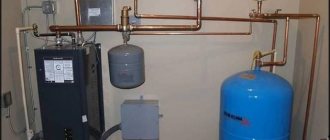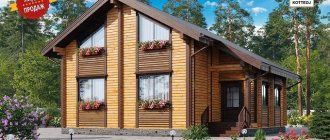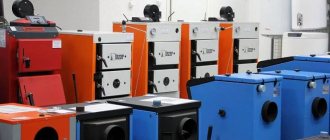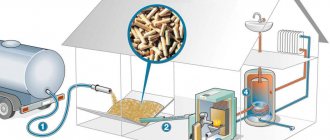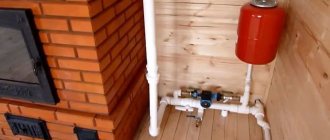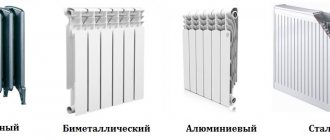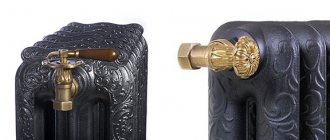- Types of electric heating for a private home
- Electrical "warm floor" systems
- Types and design of electric heated floors
- Heating cable
- Self-regulating cable
- Heating mat
- Infrared film
- Rod heated floor
- Is heating only effective with underfloor heating?
- Convectors, fan heaters, oil radiators, etc.
- Infrared heaters
- Electric boilers (radiator system)
Electric heating of a private home may seem unprofitable compared to gas, but this is not entirely true. It has many advantages:
- there is no need to obtain permits and approve the project, as is the case with gas;
- there are fewer installation costs, and some electrical systems can be installed by yourself;
- safety (when heating with gas, there is a danger of gas leakage and fire, as well as carbon monoxide poisoning);
- environmental friendliness - no combustion products;
- there are more options for choosing a heating system, whereas in the case of gas it is actually only water heating with a boiler and radiators.
In addition, electric heating is available wherever there are power lines (that is, 99% of the territory of Russia), and gas heating is only available where a gas pipe is connected.
Method 1 - electric convectors
With the help of electric convectors it is possible to provide a cheap and efficient heating system. The electric convector is built on the principle of natural air circulation. Warm air moves upward from the heater, thus stimulating the movement of air inside the room and ensuring uniform heating. However, a convector is effective only in warm climates, when the temperature does not fall below 10-15 degrees.
pros
- No forced air blowing. Even in the cleanest home there are particulates that lie on surfaces. When warm air is artificially blown out of a heater, this dust becomes part of the air we breathe. Natural air circulation is not so active, so dust does not rise into the air.
- Small size with sufficient power. The heating elements of convectors heat up quickly, converting electricity into heat with an efficiency of up to 80%. In addition, there is a system of operation in different modes, as well as thermostats that allow operation not constantly, but only when the air temperature drops.
- Mobility, allowing you to move the convector around the room, to places with maximum cold flow.
- The possibility of creating a heating system exclusively using convectors or using them as part of a more complex heating system.
- The electric heating element does not heat up more than 100 degrees, and the body - 60 degrees. They have an increased level of protection from moisture, which allows the convector to be used in the kitchen and bathrooms.
Minuses
- The disadvantage of electric convectors is the installation of heaters in every room of the house.
- In addition, if you turn them on at the same time, there is a possibility of exceeding the permissible power limits.
However, the disadvantages can be turned into advantages by installing a relay for turning on the heaters one by one. The relay will allow you to create a stable temperature in the house, reduce energy costs and remain within the permissible power limits. There is another argument in favor of a system of convectors - they will not all fail at once. Replacing one or two appliances without losing heat is not difficult.
The photo shows an electric convector from Nobo, Norway
Electric heating system for a country house using a heat accumulator
A heat accumulator is a buffer tank that can significantly reduce the cost of heating a home. It is made of stainless or carbon steel and is wrapped with thermal insulation to reduce heat loss.
The water is heated using heating elements to a temperature of 90-95° using cheap night electricity. During the day, the time relay is triggered and turns off the energy supply to the heating elements. Heating of the premises occurs due to hot coolant from the tank. The heating system portions out water from the heat accumulator in the amount required at a particular moment.
An electric boiler can be used as a backup heat source. If the temperature of the coolant in the storage tank becomes insufficient to replenish heat loss, the boiler is started from the thermostat command to the built-in servo drive. Then the water is redirected not through the tank, but through the boiler.
If there is a problem with the heating elements, the backup heater will take on the entire load. This increases the reliability of the heating system.
If the house uses radiator heating and a “warm floor” system, 2 collectors for each type of heating are included in the boiler piping. Then each mixing unit can be adjusted and the optimal mode can be set. In the radiator network, the coolant temperature must be at least 70°C, while for heated floors 40-50°C is sufficient. Therefore, the boiler will consume the power that is necessary to heat each branch.
The desired temperature values can be set using servo drives. Thermostatic heads installed on radiators will help to additionally save heat without sacrificing comfort.
There is another way to reduce energy consumption, but it does not involve creating comfortable conditions. The boiler operates at high power all night, and during the day it either turns off completely or is set to minimum heating. In the morning the house will be hot, and by evening it will be much colder. Savings will be achieved, but the price is not acceptable for everyone.
Method 2 - tubular electric heaters
They transfer heat from a tubular electric heater to a liquid-based coolant. Typically, water and oil are used as a coolant, and sometimes antifreeze. The design principle of heaters is the same as that of electric kettles, which is why they are also called heaters and oil radiators. In fact, it is a boiler placed in a vessel with water. The efficiency of such devices is quite high, and heat loss for heating is minimal.
pros
- The undoubted advantages of tubular heaters include their safety, operational reliability and versatility of use.
- Can be used in both gaseous and liquid media.
- Not explosive, and not afraid of vibrations and shocks.
- Tubular heaters are available in a variety of design solutions, which allows you to economically heat a private home with electricity without disturbing the aesthetics of the interior.
Minuses
Heating heating elements have a high cost due to the expensive metals that are used in production. Since scale forms on the pipes, it is necessary to take care of the quality of the water.
A tubular radiator is a thin-walled metal tube with a spiral inside, so if you do not need particularly high temperatures, then you need to take a heater with carbon steel tubes. If the device must produce a consistently high temperature or operate in an aggressive environment, then you need to take a device made of stainless steel.
The photo shows a tubular electric heater made by yourself
Which option do we recommend?
Most often, residents of a house are encouraged to use electric heating by two facts: the lack of gas with a reluctance to burn with coal and the financial component.
The surest option would be to make full water heating and use an electric boiler. If any power outages occur, you can safely resort to an alternative option.
If you need to provide heat to one or two rooms, then building a full-fledged boiler room does not make sense. In this case, we would buy ordinary electric convectors and use them.
Method 4 - electric boiler with heating element
The popularity of electric boilers is determined by their safety, low cost and reliability. Most consumers opt for heating element boilers - they are much cheaper than electrode and induction boilers, and they are easy to maintain.
However, due to the use of a thermoelectric heater (TEH), such heating cannot be called the most economical. In addition, before purchasing, I recommend checking the operating mode of the local electrical networks - perhaps the networks will not cope with the load you need and the purchase will be in vain.
The photo shows an electric boiler KOSPEL, Poland
Electric boilers
Electric boilers are one of the convenient and modern types of electric heating at home. They are designed for installation in a pipeline network. An electric boiler performs the same function as a gas and solid fuel boiler. Mounted in the same network with radiators or water heated floors. The power of an electric boiler is significantly greater than that of a convector, since it heats the coolant for the entire building.
Installation of an electric boiler requires the allocation of more power and more powerful wiring. In terms of price, an electric boiler is usually cheaper than a gas one, but the overall system, including installation and commissioning, comes out to be almost the same in price. An electric boiler is often used in conjunction with a gas boiler as an emergency heat source.
Heating from an electric boiler is often used to replace gas or other systems. In this case, the pipeline network remains the same, only the boiler is replaced.
Method 5 - induction boiler
An induction boiler is a transformer with two types of winding. The resulting eddy currents follow the short-circuited loop, which is the boiler body. The secondary winding receives energy, which is converted into heat, heating the coolant.
Induction boilers heat your home quickly, can operate at low voltage, and have no parts that can fail. The efficiency of such a boiler is almost 100% and does not depend on the service life.
The photo shows an induction boiler EPO Evan 9.5 kW, Russia
Fan heaters
Electric heat fans are devices whose purpose is to ensure a stable temperature in the room and create a thermal curtain. Characteristic features of such devices are fast heating, minimal heat loss and high efficiency.
As a rule, fan heaters operate in recirculation mode, i.e. use the air in the room to heat. However, if you want to provide a more comfortable atmosphere, you can provide air intake from the street - the heating efficiency will be quite sufficient.
Method 6 - electrode boiler
Inside the electrode boiler there are electrodes, which act as a heating element. When current passes through a liquid, heat is generated. This means that in electrode boilers there is no actual heating element on which scale could form. The absence of scale will greatly facilitate operation.
Electrode boilers are highly reliable and operate much longer than tubular heaters. In addition, they are small in size, which is very convenient for a small residential building. The disadvantages include high requirements for the liquid used as a coolant. Water must undergo special treatment. Often, antifreeze generally must be exclusive - from the device developer.
The photo shows an electrode boiler Galan, Russia
Top 10 rating according to KP
Editor's Choice
Professor Butakov Student (from 12.2 thousand rubles)
Professor Butakov Student.
Photo: yandex.market.ru A stove that is easy to use and easy to install. The chimney in most homes does not require any additional installations or holes. The model is very compact and heats the room well. The device heats up quickly. Such a stove would look great in any country house or country house. The burning time in smoldering mode reaches 7-8 hours. The flame level can be adjusted. The power is good - 9 kW. The heating device operates on wood.
Characteristics:
| Heated volume | 150 m³ |
| Power | 9 kW |
| Type | closed |
| Chimney | There is |
| Efficiency | 85% |
| Fuel | firewood |
| Outer shell material | steel |
| Door material | steel |
| Top panel material | steel |
| Chimney diameter | 12 cm |
| Chimney connection | rear |
| Dimensions (WxHxD) | 37x65x54.5 cm |
| Weight | 57 kg |
Advantages and disadvantages
Burning time, easy to use
Poor design of gate clamp
show more
Guca Arina Low (from 42 thousand rubles)
Guca Arina Low.
Photo: yandex.market.ru The option is not cheap, but it is of high quality. Here you will find powerful heating and good quality glass that does not let air through. To prevent it from becoming dirty, use dry firewood, such as birch or aspen. In general, this model has an excellent design, it will look good in the interior and will not take up much space. The body is made of cast iron, which is considered extremely reliable. Connection to the chimney is possible from the back and top, which is very convenient.
Characteristics:
| Heated volume | 210 m³ |
| Power | 10 kW |
| Type | closed |
| Chimney | There is |
| Efficiency | 84% |
| Fuel | firewood |
| Outer shell material | cast iron |
| Door material | glass |
| Top panel material | cast iron |
| Chimney diameter | 12 cm |
| Chimney connection | back and top |
| Dimensions (WxHxD) | 48×77.50×43.5 cm |
| Weight | 115 kg |
show more
Advantages and disadvantages
Design, fast heating
Over time, there may be problems with the reliability of the door
Harvia KIP60E (from 16.1 thousand rubles)
Harvia KIP60E.
Photo: yandex.market.ru A hanging stove that can operate from an electrical network and by heating stones. It is of good quality and heat, intended for “home” baths and saunas. The cable for the heater can be released at a height of 0.5 m. The heated volume is 8 cubic meters. The power of 6 kW and the capacity for 25 kg of stones will do everything to ensure that the room warms up quickly and evenly, and you can quickly warm up and relax. The materials in the model are said to be reliable, so it should last a long time.
Characteristics:
| Heated volume | 8 m³ |
| Power | 6 kW |
| Type | hanging stove |
| Network operation | Yes |
| Type | closed |
| Remote control | remote control |
| Dimensions (WxHxD) | 41x60x28 cm |
| Weight | 16 kg |
| Additional Information | maximum weight of stones 25 kg |
Advantages and disadvantages
Quality, functionality
Electricity consumption
show more
What other ovens are worth paying attention to?
THORMA Bozen (from 30.6 thousand rubles)
THORMA Bozen.
Photo: yandex.market.ru Compact model with an elegant design. Easy to install and configure. It is easy to wash and clean. It works on wood, the main thing is to choose dry ones and not exceeding a length of 35 cm. The flame level in the stove can be adjusted. According to user reviews, it lasts for a very long time. The clean glass system helps keep the door in good condition. There are several body colors to choose from, depending on your wishes.
Characteristics:
| Heated volume | 124 m³ |
| Power | 5 kW |
| Type | closed |
| Chimney | There is |
| Efficiency | 72% |
| Fuel | firewood |
| Outer shell material | steel |
| Door material | glass |
| Chimney diameter | 12 cm |
| Chimney connection | rear |
| Maximum length of firewood | 35 cm |
| Dimensions (WxHxD) | 32.60×90.60×34.50 cm |
| Weight | 60 kg |
| Additional Information | color: black, white, beige, burgundy |
Advantages and disadvantages
Functionality, build quality
No instructions in Russian
show more
NMK Sibir BV-180 (from 17.4 thousand rubles)
NMK Sibir BV-180.
Photo: yandex.market.ru A floor-standing stove designed to warm the air. The metal and reliable structure consists of eleven interconnected round pipes that provide natural convection. Thanks to this, the air is quickly heated and distributed smoothly throughout the entire volume of the room. The stove can heat houses, workshops, greenhouses, garages and more. The declared power of the furnace is 7 kW. The stove operates on wood and stove gases, which remain after they smolder.
Characteristics:
| Type | floor oven |
| Heated volume | 180 m³ |
| Power | 7 kW |
| Type | closed |
| Chimney | There is |
| Efficiency | 85% |
| Fuel | combined |
| Secondary combustion | There is |
| Firebox volume | 42 l |
| Outer shell material | steel |
| Firebox material | steel |
| Chimney diameter | 11.5 cm |
| Chimney connection | rear |
| Dimensions (WxHxD) | 45x68x88 cm |
| Weight | 82 kg |
| Additional Information | wood, wood waste, cardboard, briquettes |
Advantages and disadvantages
Heats up quickly, long burning function
Inconvenient to clean
show more
TMF Indigirka-2 (57 thousand rubles)
TMF Indigirka-2.
Photo: yandex.market.ru This product is not cheap, but its quality is good. The stove is wall-mounted. The characteristics are powerful. So, the heated volume is 50 cubic meters. Power is 4 kW, which is not a low figure. Almost any firewood will be suitable as fuel. The connection to the chimney here is from the top, the maximum length is no more than three meters. There is a cooktop which is a great bonus. The model is made of steel and is distinguished by enviable reliability.
Characteristics:
| Heated volume | 50 m³ |
| Power | 4 kW |
| Type | closed |
| Chimney | There is |
| Efficiency | 85% |
| Fuel | firewood |
| Outer shell material | steel |
| Door material | glass |
| Top panel material | steel |
| Chimney diameter | 8 cm |
| Chimney connection | top |
| Dimensions (WxHxD) | 44×65.50×43 cm |
| Weight | 37 kg |
| Additional Information | minimum chimney height 3 m |
Advantages and disadvantages
Quality, compactness
Price
show more
Convection Varna 100H (from 8900 rubles)
Convection Varna 100H.
Photo: yandex.market.ru This is a more budget option. The heating stove can operate in rooms with a volume of up to one hundred cubic meters. We are talking about both residential buildings and production workshops. There is a flame adjustment and a long burning system, which is very convenient. The device weighs relatively little, which is also very convenient. The increased cooking surface area of the oven allows you to place quite large containers on it.
Characteristics:
| Heated volume | 100 m³ |
| Type | closed |
| Chimney | There is |
| Fuel | firewood |
| Outer shell material | steel |
| Door material | steel |
| Dimensions (WxHxD) | 53x57x52.60 cm |
| Weight | 36 kg |
Advantages and disadvantages
Price, quickly warms up the room
Not equipped with gate
show more
This is interesting
The best wall-mounted split systems for a country house
Vesuvius Mini (from 3600 rubles)
Vesuvius Mini.
Photo: yandex.market.ru Compared to its competitors, this is a fairly cheap floor-standing stove. It looks simple, but, according to users, it holds heat well and warms up very quickly. The model is distinguished by a very reliable metal that will last for several years. The device runs on wood. There is a convenient chimney here. Buyers note that such a stove will be suitable in a private home, but it will perform even better in a garage. And if you wish, you can even cook barbecue in such a stove.
Characteristics:
| Type | floor oven |
| Type | closed |
| Chimney | There is |
| Firebox wall thickness | 0.5 cm |
| Outer shell material | steel |
| Door material | steel |
| Firebox material | steel |
| Chimney diameter | 11.5 cm |
| Chimney connection | top |
| Dimensions (WxHxD) | 30x45x50 cm |
| Weight | 20 kg |
Advantages and disadvantages
Price, reliability
Wall thickness
show more
TMF Fire-battery 7 (from 13 thousand rubles)
TMF Fire-battery 7. Photo: yandex.market.ru
High-quality wall-mounted stove with outlet through the wall. It has a solid heated volume of 150 cubic meters. The power is also good - 10 kW. The firebox volume is almost 50 liters, which many will also like. The stove in the houses is working. This model is suitable for owners of country houses. When fully loaded, it can provide up to 10 hours of heating, while the air in the room warms up very quickly. The price of the device is also not the highest on the market.
Characteristics:
| Heated volume | 150 m³ |
| Power | 10 kW |
| Type | closed |
| Chimney | There is |
| Fuel | firewood |
| Firebox volume | 47 l |
| Door material | glass |
| Chimney diameter | 12 cm |
| Chimney connection | back and top |
| Dimensions (WxHxD) | 37x76x68 cm |
| Weight | 52 kg |
| Additional Information | slot convector; minimum chimney height 5 m |
Advantages and disadvantages
Easy to kindle, compact
When overheating there is a smell from the steel
show more
Breneran AOT-06/00 (from 11.1 thousand rubles)
Breneran AOT-06/00.
Photo: yandex.market.ru A stove designed for heating air in different types of rooms. It is an all-welded steel structure coated with heat-resistant paint. It is possible that during the first heating there will even be a characteristic smell, but do not rush to give up, this will not happen in the future. The device consists of two combustion chambers - the lower one, where gasification occurs, and the upper one, where gases are burned. The front pipes also have afterburner injectors. The stove type is floor-standing, so first select a place for it.
Characteristics:
| Type | floor oven |
| Heated volume | 100 m³ |
| Power | 6 kW |
| Type | closed |
| Chimney | There is |
| Fuel | firewood |
| Firebox volume | 40 l |
| Chimney diameter | 12 cm |
| Chimney connection | rear |
| Dimensions (WxHxD) | 43.50×63.20×60.80 cm |
| Weight | 55 kg |
Advantages and disadvantages
Easy to heat, high efficiency
No ash pan
show more
This is interesting
The best heaters for your home
Method 7 - infrared heaters (the most economical)
Infrared heaters are considered the most economical of all types of electric heaters. They do not need heating elements and water pipes. Infrared heaters heat objects, not the room. Then the heated objects heat up the air. If an electric boiler can be compared to a kettle, then an infrared boiler can be compared to a microwave oven.
Infrared panels are especially popular. They are installed on the ceiling or walls of residential and industrial premises. Since the heating area is increased, the room becomes warmer faster than usual. Such a panel can be used as an independent heating source or as an addition to an existing system. An infrared heater goes well with electrode boilers. For example, an infrared heater can only be turned on in spring and autumn, when it is too early to turn on the main heating, or when it suddenly gets cold outside.
Pictured is a GROHE infrared panel, Germany
What is the best choice for your home?
One of the most important stages in arranging a heating system is the choice of an energy source that can ensure heating of the coolant to optimal temperatures.
Criterias of choice
The main criterion for choosing a combined heating device is performance. The power of the furnace must be sufficient to effectively heat the area of the house.
You can calculate the required productivity in two ways:
- Averaged. The calculation is based on the ratio of 1 kW of power for every 10 m of area in a building with a ceiling height of no more than 2.5 m. So, for a small dacha with an area of 50 m², you need a 5 kW boiler; to heat a country house with an area of 300 m², you will need an installation device with a power of 30 kW.
- Based on heat loss. With this technique, the furnace power is calculated using the formula:
N=Q*S/1000, where;
- Q - level of heat loss, W/m² (for example, in monolithic houses without additional thermal insulation it ranges from 120 to 200 W/m², in brick houses - from 90 - 120 W/m², for buildings with modern thermal insulation and three-layer double-glazed windows - about 60 - 90 W/m²);
- S is the area of the house.
In addition to power, when purchasing a device, you should pay attention to the following factors:
- combustion chamber volume. The frequency of fuel loading depends on its size;
- What material is the heat exchanger and grate made of? The best material for the manufacture of these structural elements is cast iron. It is less susceptible to corrosion, heat resistant and suitable for any type of fuel;
- presence of a safety valve. This device is designed to ensure safe operation of the heating system. If there is a sharp surge in pressure in the system, the valve will automatically release part of the liquid into a prepared container;
- number of circuits. It is better to choose models in which water heating is carried out not by separate heating elements, but by means of a coil mounted in the combustion chamber;
- overall dimensions and weight of the device. Products must
conclusions
- It is generally accepted that heating a house with electricity is not cheap. This is certainly true if we mean only payment according to tariffs. However, to the price of heating you need to add the cost of the equipment, as well as the costs of its maintenance and repair.
- If you compare bills for electricity, firewood, coal, pipes, boilers and other equipment, you can come to the conclusion that private heating with electricity is cheaper than solid-state boilers, stoves and other systems alternative to gas heating.
- In addition to money, there is another argument in favor of electric heating - it saves time: turn it on, leave and forget. The only downside is a sudden power outage.
Below, watch a video about how we managed to create cheap heating with electricity for a large private house.
Disadvantages of work
The main disadvantage of electric heating is the high energy consumption. In some areas, energy prices are quite high, so this method may simply not be profitable.
The second disadvantage is energy dependence. If the electricity is turned off for any reason, heating the room will become impossible.
Using a generator.
The third disadvantage can be considered the unstable voltage in the power grid, especially in rural areas. Purchasing your own generator eliminates this problem, but significantly increases financial costs.
Have you decided to heat your house with electricity? It is necessary to take into account the condition and power of the electrical wiring. For a large private house, a three-phase power supply may be needed. You will need to find out exactly how much power is allocated to the house and what part of the allocated power can be used for heating.
Features of operation
To light the stove, you can use wood chips or splinters. They need to be placed in the combustion chamber and set on fire. After the fire has flared up, larger firewood is laid. The air dampers should be open at this moment; you can close them after the fire has engulfed the logs.
Heating a room with an electric wood stove, regardless of where exactly it is located, can be potentially dangerous. Therefore, there are safety precautions during operation designed to reduce dangerous situations to a minimum:
- a metal sheet must be laid on the floor in front of the combustion door;
- Grounding must be connected to the device body;
- Clean the chimney in a timely manner.
Where is the best place to install?
A wood-burning and electric stove must be installed in a room with a normal level of humidity, the walls of which are lined with non-combustible materials. The choice of location is determined depending on the decoupling scheme of the heating system.
General connection diagram
An asbestos board is placed under the device, which simultaneously serves as a leveling layer and protects the floor covering from fire. The room must be equipped with high-quality supply and exhaust ventilation and a chimney. Special requirements apply to the electrical network in the room:
- the brand and cross-section of the electrical wire must correspond to the maximum current consumed by the furnace;
- It is recommended to connect the unit to the network via a differential relay, which will operate if there is a current leak of 30 mA;
- devices with a power of 2 - 5 kW are usually designed for a supply voltage of 220 V and are connected to a regular single-phase power line at home. More powerful stoves are produced for a voltage of 380 V; to connect them, a three-core cable is required.
Selection of the optimal heating scheme
To heat a home, the following schemes are most often used on how to install a heating boiler in a private house:
- Single-pipe. One manifold supplies all radiators. It plays the role of both supply and return, as it is laid in a closed loop next to all the batteries.
- Two-pipe. In this case, separate return and supply are used.
To choose the most optimal installation scheme for a heating boiler in a private home, it is recommended to consult a specialist. However, in any case, a two-pipe system is a more progressive solution to the question of which heating scheme is better for a private home. Although at first glance it may seem that a single-pipe system allows you to save on material, practice shows that such systems are both more expensive and more complex.
It is important to understand that inside a single-pipe system, water cools much faster: as a result, radiators further away have to be equipped with a larger number of sections. Also, the distribution manifold must have a sufficient diameter that exceeds the two-pipe distribution lines
In addition, in this scheme there is a serious difficulty in organizing automatic control due to the influence of the radiators on each other.
Small buildings such as dachas, where the number of radiators does not exceed 5, can be safely equipped with a single-pipe horizontal heating system for a private house with your own hands (it is also called “Leningradka”). If the number of batteries is increased, there will be malfunctions in its functioning. Another application of such an interchange is single-pipe vertical risers in two-story cottages. Such schemes are quite common and work without failure.
The two-pipe decoupling ensures that the coolant is delivered to all batteries at the same temperature. This allows you to avoid building up sections. The presence of supply and return pipes creates optimal conditions for the implementation of automatic control of radiators, for which thermostatic valves are used. In this case, you can take pipes of smaller diameter and simpler designs.
What are the heating schemes for a private two-pipe type house:
- Dead-end. In this case, the pipeline consists of separate branches, inside of which counter movement of the coolant is used.
- Associated two-pipe. Here the return serves as a continuation of the supply, which ensures an annular movement of the coolant inside the circuit.
- Radiation. The most expensive schemes are those where each radiator has a separately laid hidden line (in the floor) from the collector.
If, when laying horizontal pipelines of large diameter, a slope of 3-5 mm/m is used, then a gravitational method of operation of the system will be achieved, and circulation pumps may not be used. Thanks to this, complete energy independence of the system is achieved. This principle can be applied to both one-pipe and two-pipe schemes: the main thing is to create conditions for gravity circulation of the coolant.
In open heating systems, an expansion tank will be required at the highest point: this approach is mandatory when arranging gravity circuits. However, the return pipe next to the boiler can be equipped with a membrane expander, which will make the system closed, operating under overpressure conditions. This approach is considered more modern and is most often used in forced-type systems.
Warm floors deserve special mention when researching which heating scheme to choose for a private home. Such a system is quite expensive, since it requires laying several hundred meters of pipeline in a screed: this makes it possible to provide each room with a separate heating water circuit. The pipes are connected to a distribution manifold, which has a mixing unit and its own circulation pump. As a result, the rooms are heated very evenly and economically, in a manner that is comfortable for people. This type of heating can be used in various residential areas.
Other heat sources
To estimate how much an electric heating boiler consumes per month, you need to compare it with other energy sources. It should be taken into account that the efficiency of fuel boilers does not reach a hundred: for gas boilers it is about 93%, for wood and coal boilers it is about 85%.
Below is the cost per 1 kWh for different types of fuel:
- Natural gas: 0.68 rubles, taking into account efficiency – 0.75 rubles.
- Oak firewood: 1.09 and 1.36 rubles, respectively.
- Coal: 1.33 and 1.57 rubles.
- Wood pellets: 1.51 and 1.78 rubles.
- Liquefied gas: 1.99 and 2.13 rubles.
- Diesel fuel: 3.51 and 3.90 rubles.
In each case, heating costs for the season will be (for 17,388 kWh):
- natural gas: RUB 13,041;
- oak firewood: RUB 23,648;
- coal: RUB 27,300;
- wood pellets: RUB 30,950;
- liquefied gas: RUB 37,036;
- diesel fuel: RUB 67,813.
The average price level is given.
In cases where it is not possible to use a solid fuel or gas unit, installing an electric boiler for heating a private home is a good option.

